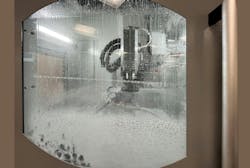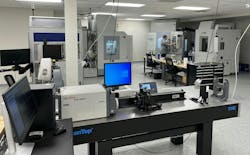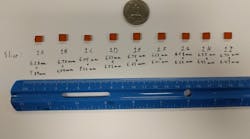AmeriCOM’s mission is to design and execute workforce training programs to support the nation’s optics industry, develop optic manufacturing technologies to support scalable manufacturing, and to transition mission-critical precision optics technologies from research to sustainable manufacturing operations.
The Defense Precision Optics Consortium (DPOC) is AmeriCOM’s member-based organization, which is working to catalyze commercialization of new mission-critical optics technologies to support the defense optics industrial base. Its three key areas of focus are currently: optics fabrication automation, addressing critical materials supply chain challenges, and improving development of challenging optics for directed energy or hypersonic applications.
“Our tri-service military advisory board defines the U.S. Department of Defense’s (DoD) precision optics needs for applications like high-energy lasers, cameras, and satellites,” says Justin Sigley, chief scientist for AmeriCOM and DPOC. “And then we put out solicitations for research proposals from our consortium members.”
Fairport, NY optics manufacturing facility/equipment
DPOC’s facility in Fairport, New York, located nine miles east of Rochester, is open for business—with state-of-the-art optics manufacturing machines for everything from spherical optics to more advanced freeform optics.
“Members can rent time on our machines with our technicians, who are trained to run all of the machines, to prove out their prototype process,” says Sigley. “It reduces the risk to invest their own capital once they see a proven path to success.”
Membership is open to any U.S.-based entity, and you’re encouraged to join the consortium via their website. Members gain early access to research solicitations, can rent time in the user facility, and can access AmeriCOM’s nationwide network of optics technician training ecosystems or its Light Up Your Future With Optics program.
Right now, joining the consortium is free and allows you to look at their proposals. “We’re currently putting out solicitations for new research and advocating for the precision optics community to DoD leaders and Congress,” says Sigley.
Optics fabrication automation
The work between AmeriCOM’s workforce training side and the DPOC research side is synergistic and focuses on developing better ways to train technicians to tackle the challenges emerging on the horizon.
Most nonprecision optics are manufactured overseas because it can be done at a lower cost. Precision optics for the DoD are manufactured in the U.S., but it’s a struggle to drop their cost.
“Simply hiring more technicians to do the work won’t solve the problem, but if the work of a technician can be made more productive, costs can drop,” says Sigley. “This might involve putting some type of automation learning into optics machines used for fabrication. Instead of having one technician working on one machine constantly, some tasks can be passed off to the machine so that one technician can work three or four machines at a time.”
Critical materials/supply chain needs
Another key area DPOC focuses on is critical supply chain issues, such as the shortage of availability of rare earth elements like germanium, which is used for a lot of military optics.
“Because of the Chinese export controls that came out in 2023 and the more recent Chinese bans of exporting germanium, gallium, and antimony to the U.S., we’re having a hard time getting germanium in the U.S.,” says Sigley. “We’re primarily interested in germanium for the infrared needs of the DoD. There are several kilograms of germanium in every tank sight and solar panel, and not being able to get this material is a big and expensive problem.”
The consortium has several different projects underway within this realm. One involves trying to use less germanium through advanced optical design and fabrication. Another is exploring alternate materials like chalcogenides that can be used in place of germanium (think LightPath Technologies or the work of Professor Kathleen Richardson’s team at the University of Central Florida’s College of Optics and Photonics). Some of these alternatives still contain germanium but much less than, say, a full germanium lens system.
Related Articles
Research into recycling efforts is also underway in terms of recycling chalcogenides. How many times can we melt down and reuse the material before its properties start to change? “We’re funding this type of work,” says Sigley.
Another area being explored is recycling scrap materials that come out of the machining tools. “Can we domestically refine scrap to the purity we need for optics in a cost-effective way? A lot of refining is done overseas and doesn’t come back,” points out Sigley. “We want to stand up some refinement capabilities here in the U.S. Any efforts to increase germanium extraction in the U.S. are still a few years out, so we’re trying to come up with ways to mitigate some of the supply chain issues we’re seeing within the short term.”
‘Challenging research optics bucket’
DPOC has a “challenging research optics bucket,” which focuses on the very small, very big, or very difficult stuff.
“Our biggest focus here is within the directed energy realm,” says Sigley. “It’s one of the top three topics within DoD optics right now. Demonstrations of directed energy haven’t always gone well, in large part due to optics failing. We need to ensure the optics can withstand these high-energy beams.”
Plenty of optics manufacturers can make optics to withstand this energy, “but we’re discovering problems often occur during their integration,” says Sigley. “If a fingerprint or dust gets onto the optic, it’s more prone to failure. There are a lot of logistics involved in their shipping and installation that need to be done in a way to ensure they’re kept clean and we’re not installing them with materials that can outgas over time and create problems for the optics down the road.”
These high-energy laser weapons systems will eventually be out on the battlefield, where they’ll likely be maintained by a 19-year-old with a Leatherman. “It’s not feasible to bring an entire Stryker vehicle back to a lab to fix a high-energy laser weapon’s optics,” says Sigley. “We need line-replaceable optical units. If an electronic board goes out, you pull it out and install a new one. Why can’t we do that with optics? We’re trying to figure out if we can make assemblies of optical systems that are self-contained and very clean so they can be shipped out to the field and ‘ripped and replaced’ as needed.”
To do this, DPOC is working with partners from across the defense space and local industry. “We’re developing standards for cleanliness and how to measure the performance of these optics under high-energy beams to ensure they won’t blow up within these systems,” says Sigley. “The traditional way to measure the optics’ performance is laser damage threshold testing. But it’s destructive testing—and we don’t want to destructively test the optics going into the system. So coming up with ways to measure and test these optics before they go into these systems to ensure they’ll perform well is another big challenge we’re working on.”
Interested in joining DPOC? Visit americom.org/optics-manufacturing-technologies-research.
More on AmeriCOM
About the Author
Sally Cole Johnson
Editor in Chief
Sally Cole Johnson, Laser Focus World’s editor in chief, is a science and technology journalist who specializes in physics and semiconductors.





